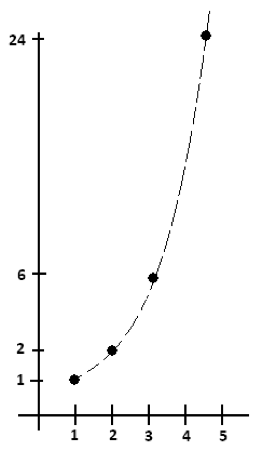Permutations and Combinations
2.4 Aside: Leonhard Euler and Factorials
We have:
\(1! = 1\)
\(2! = 2 \times 1 = 2\)
\(3! = 3 \times 2 \times 1 = 6\)
\(4! = 4 \times 3 \times 2 \times 1 = 24\)
\(5! = 5 \times 4 \times 3 \times 2 \times 1 = 120\)
\(6! = 6 \times 5 \times 4 \times 3 \times 2 \times 1 = 720\)
\(7! = 7 \times 6 \times 5 \times 4 \times 3 \times 2 \times 1 = 5040\)
\(8! = 8 \times 7 \times 6 \times 5 \times 4 \times 3 \times 2 \times 1 = 40320\)
A graph of these values appears as follows:

In 1729, at the age of 22, Swiss mathematician Leonhard Euler wondered if there is a formula for a general function that “connects the dots” of the factorial numbers. And he found one! He called it the Gamma Function. The curious thing is that one can input rational and irrational values into the Gamma function and obtain meaningful answers. The Gamma function gives \(1! = 1\) and \(0! = 1\) (just as the mathematics we saw earlier suggests) and it also gives:
\(\left(\dfrac{1}{2}\right)! = \dfrac{\sqrt{\pi}}{2}\).
Crazy!
Resources
Books
Take your understanding to the next level with easy to understand books by James Tanton.
BROWSE BOOKS![]()
Guides & Solutions
Dive deeper into key topics through detailed, easy to follow guides and solution sets.
BROWSE GUIDES![]()
Donations
Consider supporting G'Day Math! with a donation, of any amount.
Your support is so much appreciated and enables the continued creation of great course content. Thanks!
Ready to Help?
Donations can be made via PayPal and major credit cards. A PayPal account is not required. Many thanks!
DONATE![]()


